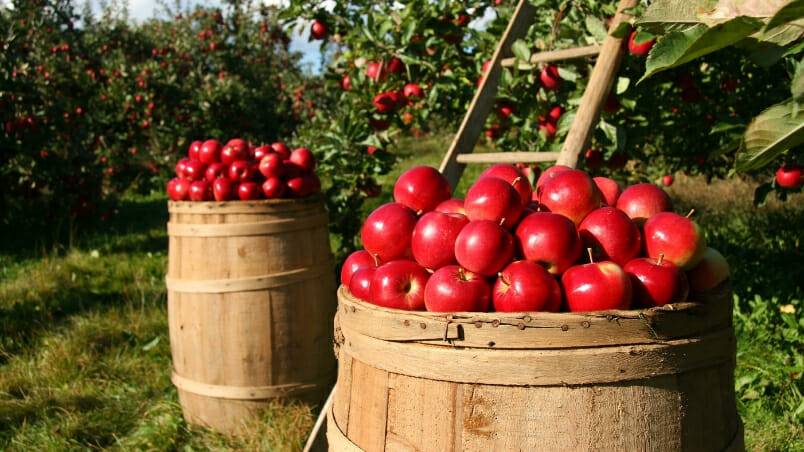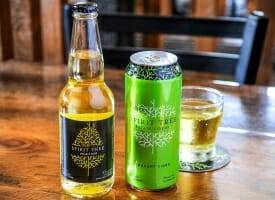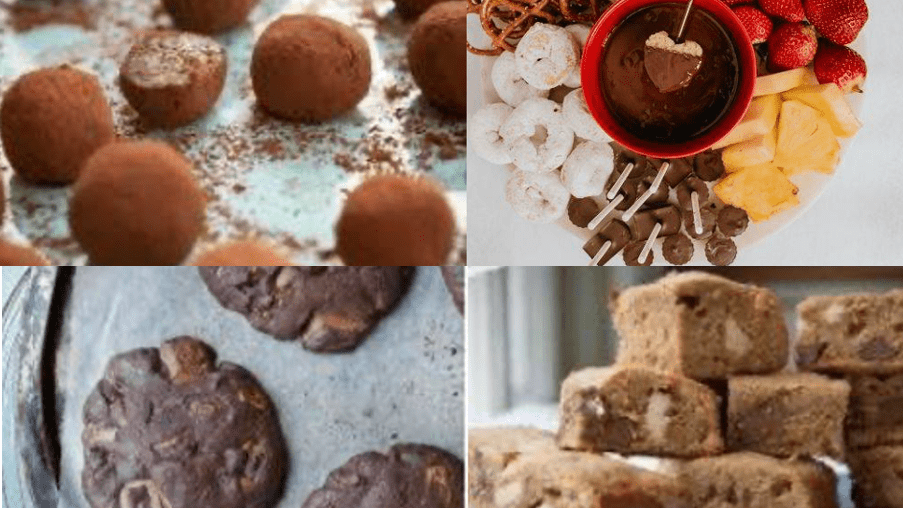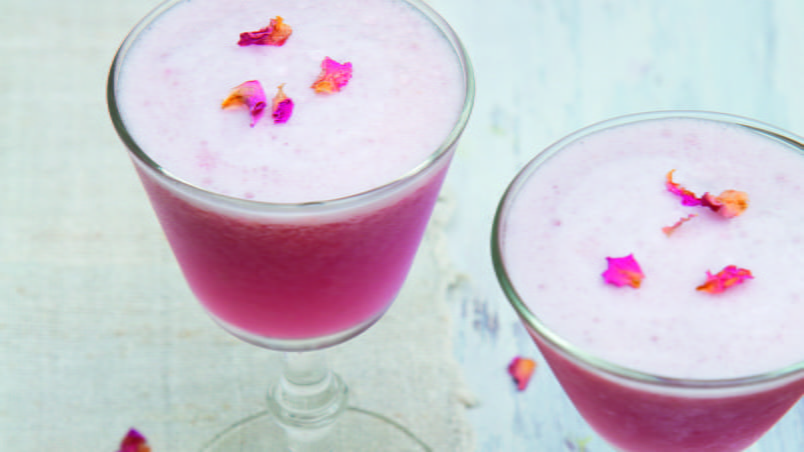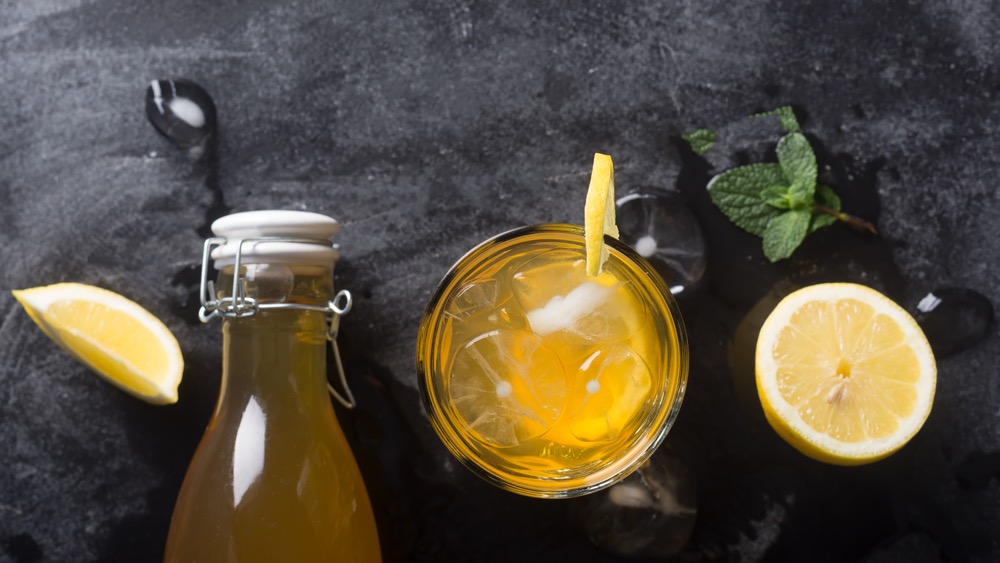To speak honestly and properly about apple cider, I first have to share a confession. Let’s just say that my grandmother, Nan, was an early forager—well before the term was hot and trending. By “forager,” I mean thrifty and resourceful (I witnessed her using a hair pick to eat coleslaw when we were a fork short on a picnic). By early forager, I mean that some thieving may have been involved. You know, freelance picking of roadside apples. My brother, sister and I were of the age when we wouldn’t have faced a jail term, but maybe a short stint at a juvenile detention centre.

Normally, we would make a pilgrimage out east to the apple orchard and market off Highway 52, near Ancaster, Ontario. From Brantford, where we lived, this outing seemed monumental, as is any trip in the car outside city limits when you’re young. Nan would only buy Spy apples from this market, and usually a whole bushel to make her famous applesauce. But there were times when we were farther south, closer to Simcoe, and the apple trees beckoned with their bounty. Nan would unload us from of the car, and we’d go into stealth mode, hopping the fence and scurrying into the orchard. We’d fill our T-shirts with a saggy load, losing a few rollaways as we mounted the fence again back to the vehicle. With hearts pumping with adrenalin and farmer fear, we’d unload the cache into the trunk and peel away from the gravel shoulder, never looking back.
Hush money and spies
My apologies to those particular apple growers. And the farmer with the corn, too. If I’m confessing about apple pilfering, I might as well come clean about the corn incident. Nan was city born and bred. My siblings and I were country stock, though, and we were of an age when we didn’t know the difference between cattle corn and the peaches ’n’ cream variety for humans. Again, resourceful Nan thought we could find a free meal in the corn field, so she had us scurry out to pick a fast dozen. For anyone who has tried this, you’ll know that no amount of boiling softens cattle corn, and the kernels are a starchy, chewy mash.
So, corn stealing came to an abrupt halt, and we returned to apple foraging. If I get bonked by a fallen Mac apple this fall, I’ll know it’s a “hi” and “HEY!” from my grandmother. She will be hollering from the heavens above, “You weren’t supposed to tell anyone!” Nan did keep our pockets lined with “hush money,” which made us feel like mini Italian mob members.
The hush money and lies were well worth the deception. Nan’s applesauce was perfect in its consistency. It wasn’t sickly sweet or overpowered by cinnamon. Whenever we dropped in for a visit, I routinely went into her pantry with a Bargain Harold’s shopping bag, bottoming it out with jars of her applesauce and pickled beets. “I want those jars back!” she’d say.
Before I loop back around to apple cider (where this confession first began), I have to tell you that her applesauce was made the old-school way. There was no shiny KitchenAid blender or Vitamix Professional Series. Nan made applesauce with 100 percent grandma mashing power.

The soft cider years
Whenever Nan made an official bushel purchase from Bennett’s for applesauce production, a two-litre (two quart) jug of apple cider was always added to the bill. Nan was the one who introduced me to cider. When we returned home from the pastoral drive, she would line up the glasses and we’d drink it cold. We usually had a burping contest after chugging it, but that’s another story. We also used to pair it with a stack of Nilla cookies smeared with Betty Crocker French vanilla frosting, if you want the full story. But again, the hush money: “Don’t tell your father I spoiled your dinner.”
When my mom served us cider, it was always piping hot. She’d simmer it on the stove with cinnamon sticks bobbing about, adding pinches of nutmeg and cinnamon. We never drank it cold at home.
When I moved to Vancouver at 19, I quickly discovered apple cider with personality. Bars in the lower mainland sold not only hard (alcoholic) apple cider, but also peach and pear ones from the Okanagan. This was in the mid-’90s, and I’ve often wondered why it took so long for the cider movement to make its way across Canada. But that was just my personal apple cider history. To trace back Canada’s cider route, the road travels centuries back to the United Kingdom and France.

A condensed history of the farmhouse drink
Although hard cider was new to my 19-year-old self in Vancouver, the humble “farmhouse drink” was actually being downed back in the 17th century. In 1617, Louis Hebert, an apothecary from Paris, was one of the early settlers to New France (Quebec). He planted the first apple tree in the history of Quebec. In Mont Royal, New France, ambitious priests planted an orchard and erected a cider mill, which become Canada’s first cidery.
Rumours abound in cider history, of course. There are stories praising Captain Cook and the Hudson’s Bay Company as the early ambassadors of cider for its scurvy prevention. Did the British introduce us to cider? Back in the western regions of the U.K. and France, climatic and soil conditions were more favourable to apples than grapes. Every farm had a few cider apple trees, distinct for their bitterness from tannins and astringents. Cooking and dessert apples were grown, too.
In the 18th century, it was commonplace for a labourer’s wage to be paid, in part, in cider. Fruits of your labour, indeed! The average labourer would “earn” three to four pints a day until a campaign stopped payment in the form of booze. A clause in the Truck Act of 1881 prohibited this unique payment plan.
Founder bragging rights aside, the cider scene here first flourished in Quebec, and the fan club spread in apple belt regions across Canada: Ontario, Nova Scotia and British Columbia.
Amateur cider makers added raisins, molasses and sugars to increase the alcohol content, maturing their creations in rum or port barrels. Apple trees grew easily, and French settlers began feverishly planting them in the 16th century. In the 1700s, New England planters and Loyalists introduced new varieties. Apples are extreme heterozygotes—each tree planted from seed(versus trees that are grafted)results in unpredictable fruit.

When barley upset the apple cart
In the early 1900s, Prohibition and the temperance movement increased the production of non-alcoholic cider and juice. When refrigeration was introduced in the 1920s, the shift went even further.
Soon, beer pushed out cider because of its longevity: apples were expensive to transport to cities for production, and barley didn’t spoil as easily. Sweeter apple varieties were being cultivated for desserts and culinary uses while cider apples fell to the wayside.
The return to heritage has been profitable. A 2013 study commissioned by the Ontario Craft Cider Association suggested that craft cider sales would surge as one of the fastest-growing categories at the Liquor Control Board of Ontario (LCBO), with sales rising from $1.13 million in 2013 to $35 million by 2018. In 2014, there were over 60 artisanal cideries in Quebec.
In the late 1980s, ice ciders emerged on the scene. In 1989, Christian Barthomeuf marketed a cidre de glace.Similar to how its cousin, icewine, is made from frozen grapes, ice cider is made from frozen apples harvested in the fall or winter. The increased concentration of sugar makes it syrupy sweet and increases the alcohol content.
Other cider makers, such as John Brett and Andrew Bishop of Tideview Cider in the Annapolis Valley, Nova Scotia, have played with heirloom varietals. Since 2005, Brett and Bishop have had fun blending golden russets, Ribston Pippins and wild crab apples.
Of cider giants and indies
Everyone is hopping on the apple cart, including Stella Artois, with its Belgian Cidre. Brands like Carlsberg-owned Somersby, as well as Strongbow and Magner’s Irish Cider, were early contenders on the market, before all the indies poured in. Cider giant Strongbow originated in England in 1962 and is now distributed by powerhouses like Heineken and SABMiller, making it one of the top sellers in North America and Australia. (Props to Strongbow’s guerilla gardening initiative, Nature Remix, which promotes the repurposing of abandoned buildings and urban plots as apple orchards.) Magner’s started making cider in 1935 and uses 17 apple varieties, patiently letting the cider mature for two years. Based in Walden, New York, Angry Orchard first hit the market in 1995, riding on the Middle Ages theory that cider was safer to drink than water. With options like Cinnful Apple, Apple Ginger and Tapped Maple, it’s best to be safe.

Artisan cider vs. craft beer
Cider is chasing the burgeoning craft beer scene with slick packaging and playful names. It’s versatile, brunch friendly and easy to pair with food (I’m sure those frosting-topped Nilla cookies of my grandmother’s would be a lovely match).
It has become a game changer for backyard barbecues, picnics, weddings and agritourism. An afternoon spent picking apples for pies or applesauce harkens back to homesteader days. Plucking an apple from a tree and giving it a good shirt shine swiftly transports you back to life as a pioneer, where the rewards were homegrown and simple.
For me, it will remind me of my earliest foraging days, with my grandmother and a getaway car on the backroads of southern Ontario. Though my Nan was a teetotaler, she might just hand over some hush money if she were offered an elderflower cider.
Tasting… 1, 2, 3
A micro-guide to Ontario’s sweetest cider houses.
If you’re looking for a sparkling alternative to beer or wine, the bright, carbonated kick of ciders are a proven solution. With cider makers exploring new blends, like black cherry and elderflower, it’s worth a fall road trip to see the production process first-hand, from apple tree to bottle. Or host a tasting afternoon with the gang. Better yet, get the gang to join you on a city bar hop.
In Toronto, for example, cider bars are pulling in crowds with over 25 fancy regional tap offerings.
In The Six, The Cider House (391 Roncesvalles Ave.) offers sinful pairings, like Newfie Savoury Fries (fries loaded with stuffing and cheese), that are just the magnet.
Also in Toronto, Her Father’s Cider Bar + Kitchen (119 Harbord St.) has been riding the crest of the “cider tsunami,” according to the Autumn 2016 edition of the Liquor Control Board of Ontario’s (LCBO) More Food & Drink. With the bar offering more than a hundred international ciders to choose from, plus sophisticated pairings, you’ll have to plan a few visits to make your way through the hopped, flavoured and spiced ciders. Owner Joshua Mott’s parents are the proprietors of Beaver Valley Craft Cidery, so you’re in good hands.
Though the daydream-envisioned cider house with a tasting room hasn’t been built yet, you can still purchase Brickworks Ciderhouse products at the LCBO (or at Her Father’s Cider Bar + Kitchen). Toronto’s first cidery was founded by childhood friends Chris Noll and Adam Gerrits. They promise their apples won’t travel any farther than 300 km (186 miles) from seed to cider. Their first slow-fermented cider, Batch: 1904, is a tribute to the city, which is still standing tall after the Great Toronto Fire of the same year. Public transit users will undoubtedly be drawn to Queen Street 501, a premium semi-sweet cider tribute to the city’s 501 streetcar.
Chris Haworth launched West Avenue Cider in Toronto in 2013 without a cidery or an orchard. He bravely quit his job as a head chef and rented space from the husband-and-wife-crafted Pommies Dry Cider in Caledon, Ontario. The Brit-born visionary ages ciders in everything from Niagara Merlot barrels to bourbon barrels. He ferments like a mad scientist, using beer, wine, wild and champagne yeasts. In December 2013, Haworth took his ongoing cask project (a concoction of pear, shiso, yuzu, ginger, amazake and a sake yeast) to the taps at Momofuku Noodle Bar in Toronto.
At Spirit Tree Estate Cidery in Caledon Hills, Ontario, you can have the full-blown experience of fresh air, a tractor ride and picking. There’s a bakery (look for the Normandy apple bread), farm shop, and the Ciderhouse Bistro, featuring hand-tossed pizza cooked in a wood-fired oven. The modern-day cidery, with a 5,000-strong orchard, hosts weekend tours and cider tastings in the province’s first winery production facility and agricultural building to use straw bale construction methods.
Bolton, Ontario’s Pommies Cider Co. is a stalwart on the scene, using 100 percent Ontario apples and pears. Their flagship Pommies Cider, Farmhouse and Perry (a blend of 100 percent Ontario Bartlett and Bosc pears) are easily recognized on shelves. To boot, all their ciders are gluten-free, GMO-free, vegan and contain no artificial flavours or colours. They are never made from concentrate.
An apple a day…
Add ciders from these Canadian companies to your shopping list, too.
Thornbury Cider (Thornbury, Ontario)
The flagship is a Mac and Granny Smith flavour mash-up from the cidery’s 3,035 hectares (7,500 acres).
Bulwark Cider (New Ross, Nova Scotia)
Try the Blush, Gold or Hopped ciders, a nod to the province’s 400-year apple-growing history.
Left Field Cider Co. (Logan Lake, British Columbia)
The Big Dry Sparkling Cider lets the Okanagan’s aromatic dessert apples show off!
Double Trouble Brewing Co. (Stoney Creek, Ontario)
It’s not apple but, Grow a Pear, made from 100 percent Ontario pears, is playful and worthy of a mention and try!
Jules Torti’s work has been published in The Vancouver Sun, The Globe & Mail, travelife, Canadian Running and Coast Mountain Culture. With experiences as a canoe outtripper, outdoor educator, colouring book illustrator and freelancer, she is thrilled to be able to curate, write and read about the very best things in life.

